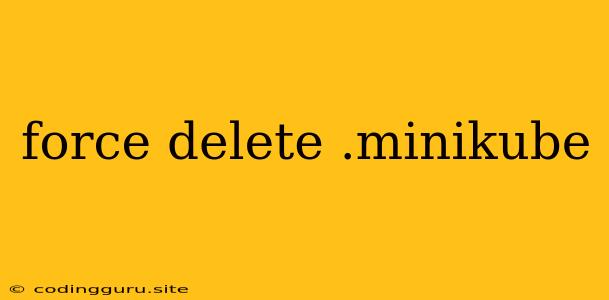Force Delete .minikube: A Comprehensive Guide
Deleting .minikube is a common task when you need to start fresh with your Minikube environment or when troubleshooting issues. While the standard minikube delete command is sufficient in most cases, situations might arise where you need to forcefully remove the Minikube virtual machine, especially when it's stuck or unresponsive. This article will provide a detailed guide on how to force delete .minikube, offering various approaches to handle different scenarios.
Understanding the Need for Force Delete
Before jumping into the process, let's understand why a force delete might be necessary. Here are some common scenarios:
- Minikube is stuck: The virtual machine might be frozen or unresponsive, making normal deletion impossible.
- Minikube is corrupted: A corrupted Minikube installation can prevent a clean deletion.
- You need a fresh start: If you're experiencing persistent issues, a fresh Minikube installation might be the solution.
The Standard Approach: minikube delete
First, try the standard minikube delete command. It's the preferred method for most deletion scenarios:
minikube delete
This command gracefully shuts down the Minikube virtual machine and removes all associated files. If this command fails or hangs, you'll need to proceed with more forceful methods.
Force Deleting Minikube: The Manual Way
When the standard minikube delete command fails, you can manually remove Minikube components using the following steps:
-
Identify the Minikube VM:
-
On macOS and Linux, you can find the Minikube VM name using:
minikube status | grep "VM" -
On Windows, the VM name will be displayed in the VirtualBox manager.
-
-
Stop the Minikube VM:
- If the VM is still running, use the following command (replace
minikube-vm-namewith the actual VM name):VBoxManage controlvm minikube-vm-name poweroff
- If the VM is still running, use the following command (replace
-
Remove the Minikube VM:
- Use the following command to remove the VM (again, replace
minikube-vm-namewith the actual name):
VBoxManage unregistervm minikube-vm-name --delete - Use the following command to remove the VM (again, replace
-
Delete the Minikube directory:
- Find the Minikube directory, usually located at
~/.minikube(on macOS and Linux) orC:\Users\<user>\.minikube(on Windows). - Delete this directory:
rm -rf ~/.minikube - Find the Minikube directory, usually located at
-
Clean up the cache:
- Delete the Minikube cache directory located at
~/.minikube/cache(on macOS and Linux) orC:\Users\<user>\.minikube\cache(on Windows).
- Delete the Minikube cache directory located at
Force Deleting Minikube: Hypervisor Specific Commands
If you're still encountering issues with the manual deletion process, you can try hypervisor-specific commands. Here are examples for VirtualBox and Hyper-V:
VirtualBox:
- Terminate the Minikube VM (if still running):
VBoxManage controlvm "minikube-vm-name" poweroff - Force delete the VM:
VBoxManage unregistervm "minikube-vm-name" --delete - Remove the Minikube directory:
rm -rf ~/.minikube
Hyper-V:
- Stop the Minikube VM (if still running):
Stop-VM -Name "minikube-vm-name" - Delete the VM:
Remove-VM -Name "minikube-vm-name" -Force - Remove the Minikube directory:
Remove-Item -Path "C:\Users\\.minikube" -Force -Recurse
Using Disk Utility for Persistent Issues
In extreme cases, where other methods fail to remove the Minikube virtual machine, you can utilize disk utility tools:
macOS:
- Open Disk Utility: Navigate to Applications -> Utilities -> Disk Utility.
- Identify the Minikube disk image: The Minikube VM will appear as a disk image in the Disk Utility window.
- Unmount the disk image: Right-click on the Minikube disk image and choose Unmount.
- Delete the disk image: Select the Minikube disk image, then click Delete.
Linux:
- Use
fdisk: Use thefdiskcommand to list available disks and identify the one containing the Minikube VM image. - Delete the partition: Once identified, use
fdiskcommands to delete the partition containing the Minikube VM. - Remove the disk image: Use the
rmcommand to delete the disk image file.
Windows:
- Open Disk Management: Search for disk management in the start menu.
- Identify the Minikube disk: Locate the disk associated with the Minikube VM in the Disk Management window.
- Delete the volume: Right-click on the Minikube disk volume and choose Delete Volume.
- Remove the disk: Once the volume is deleted, right-click on the Minikube disk and choose Delete Disk.
Important Note: Using disk utility tools should be considered a last resort as they can potentially damage your system if not used carefully.
Reinstalling Minikube
After successfully deleting the Minikube environment, you can start fresh with a new installation:
minikube start
Conclusion
Forcefully deleting .minikube requires a careful approach, ensuring you remove all associated files and components. The manual process is a common and effective method, but hypervisor-specific commands can be useful when dealing with persistent issues. For extreme cases, disk utility tools provide a last resort, but should be used cautiously. Once the .minikube environment is deleted, you can easily reinstall and start fresh with a clean setup.
